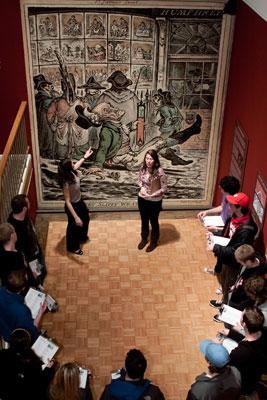Art as Language

by MaryAlice Bitts-Jackson
You’re an American in the Louvre, face-to-face with the Mona Lisa. It’s smaller than you imagined, but truly exquisite. You want to express your impressions to your friend, a Parisian who speaks no English, and if you participated in a current language-enrichment program at Dickinson, you’ll do so with confidence and ease.
Students are brushing up their museum-culture savvy while sharpening their foreign-language vocabulary and conversation skills, thanks to a program that brings introductory-level language classes to The Trout Gallery for chats about exhibitions, culture and art.
The program helps students see the practical applications of a second language at an early stage of learning, says Wendy Pires, curator of education at The Trout Gallery, who has hosted 256 classes for approximately 4,200 students thus far. “They’re conversing in a real-world context,” she explains. “And when students get out of the classroom and focus, for that moment, on objects and ideas, rather than grammar and vocabulary lists, they really open up.”
Attracting praise
Developed in 2005, the language-immersion museum discussions are part of The Trout Gallery outreach program, which provides museum programs for thousands of children from area public schools;summer sessions for local families; teacherworkshops; special events for student clubs; and museum experiences for other Dickinson classes including poetry-in-the-gallery sessions and readings; and “Out of the Vault” classes based on pieces in the gallery’s permanent collection. Students of Japanese recently caught a behind-the-scenes glimpse of the gallery’s collection of Japanese woodcuts and netsuke, and students taking the Spanish for the Business Professions class visited the gallery for a lesson about the business of international art.
These programs are attracting notice at peer institutions. Pires and Assistant Professor of Spanish Erin McNulty recently delivered a presentation about the programs to language professors at Middlebury College at the invitation of Richard Saunders, director of the Middlebury College Museum of Art.
“It’s a very innovative way to teach vocabulary and dialogue,” says Saunders, reporting that Middlebury is developing a pilot program based on Dickinson’s model. “This is an instance of hands-on learning, and for faculty open to the idea of using the gallery as a lab for language study, it has a tremendous instant benefit.”
Students inspiring students
The programs are led in the course subject language by senior-year language majors and international students, who work with Pires and language professors to develop vocabulary lists and discussion questions based on themes in an exhibition. When the introductory-level students arrive, the teaching assistants discuss the exhibition themes, hand out the lists and spark small-group conversations about the art.
“We ask them to describe, compare and contrast the paintings—to tell us what themes they see and what they’re reminded of when they see the artwork,” says Ailin “Kia” Pipkingabay ’14, a theatre-arts major from Argentina who is co-leading 38 beginner and intermediate Spanish-language sessions with Spanish major Eric Seymour ’12. “Each class is different, as each student brings his creativity into the game.”
Visitors to the gallery’s recent Tools in Motion exhibition, for example, discussed a sculpture of a casually dressed man at length, since they’d just completed a Spanish lesson about clothing. Those visiting last year’sBawdy Brits & West-End Wit exhibition learned new words relating to the concepts the Georgian-era prints evoked, such as envy, lust, gossip, stereotyping and satire.
McNulty estimates that she’s taken more than 300 of her students to The Trout Gallery so far. “Students come away thinking, ‘Wow, I can actually do something in the language that isn’t from the textbook. I can make myself understood,’ ” she says, adding that most students also are inspired by the teaching assistants who are just a few years older and have mastered the language they’re now beginning to grasp.
That participants also learn art concepts along the way is icing on the cake, says Pires. “This is good practice for the large number of Dickinson students who will study abroad,” she explains; for most students, museum and gallery trips are an important component to travel. “By the time they finish their second or third language course, they know how to get a lot out of a museum visit. They can find the ideas in a exhibition and have the language tools they need to think and talk about art.”
Published April 18, 2012